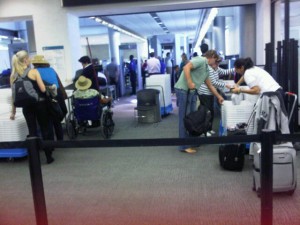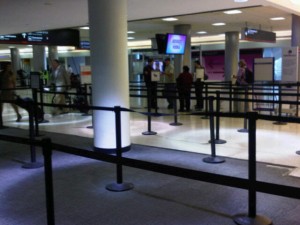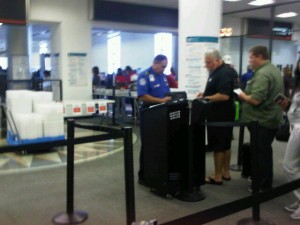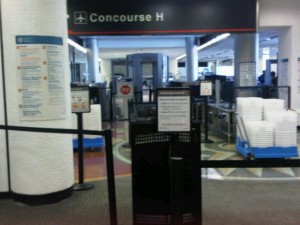Posted Oct. 16, 2012
By BRANDON LUMISH
Arriving at airport security at 7:35 a.m. for an 8:05 flight, Elaine Barnett thought she had no chance at making her flight to New York from Miami International Airport.
In a panic, Barnett, 48, was attempting to get all her liquids out of her bag, when a Transportation Security Administration (TSA) agent told Barnett that wasn’t necessary.
“The new security measures are the only reason I was able to get on that flight to visit my son in New York. What a difference they make!” Barnett said.
Passengers arriving at the airport last minute now have a better chance to make their flights. TSA is attempting to make a customers’ trip through the airport more efficient by piloting new technology at security checkpoints throughout airports in the United States.
This technology includes credential authentication, bottled liquid scanners, explosive device and explosive trace, paperless boarding passes and more. New technology is attempting to make a customer’s time through an airport as minimal as possible, especially if the customer is not a security risk.
“The new security procedures we have put into place make our jobs easier and customers’ trip through security quicker,” said TSA Agent Barbara Winker, who has worked at Miami International Airport for three years.
Credential Authentication Technology (Boarding Pass Scanning System)

Passengers right before security, putting their belongings into bins to be checked by TSA agents (Photo by Brandon Lumish).
When a passenger comes to the security checkpoint, a TSA agent has the scanning system in hand.
The scanner is able to identify whether the passenger’s identification is genuine, fake or expired.
It will light up green (like ticket scanners at many professional sport venues) if it is accepted or red if the identification is fake or expired. The scanner checks the person’s identification card against the boarding pass to make sure everything matches.
“Using the new scanners makes our job of checking identification much easier,” said Lindsay Walford, a TSA agent at Miami International Airport for one year.
Since recently airports have used new technology to allow passengers to download their boarding passes onto their cellphones, the TSA agent just uses the scanner to verify if the scanning code on the bottom of the paperless boarding pass is genuine. This technology is common now and has had the most extensive expansion thus far.
“I love that I don’t have to print out a boarding pass anymore because it was a hassle when I was away from home without access to a printer. I now save time by not waiting in line for access to a ticketing machine at the airport. It also means I have one less piece of paper to lose!” said Tina Bass, a Miami resident who was flying to New York.
New Imaging Technology
This imaging technology, called Pro Vision, is used for every passenger or employee at airports who goes through security. The technology allows the screener to check passengers for metallic and nonmetallic threats. Pro Vision has been instituted in nearly every airport across the country.

Lines at Miami International Airport, with TSA agents checking boarding passes (Photo by Brandon Lumish).
The newest imaging developed is called biometrics.
It is a retinal scan that uses fingerprint identification or eye identification.
The scan can use either, or a combination of the two, to verify who you are.
“Seeing new technology at the airport makes me feel so much safer every time I go to the airport. I feel very comfortable,” said Susan Crass, a Miami resident.
Bottled Liquid Scanners and castScope
The bottle liquid detection software checks liquid for any immediate threats. Able to quickly differentiate whether a liquid could be harmful, the bottled liquid scanners are rapidly spreading throughout airports across the country. Small amounts of liquid are no longer a threat to airports, but this scanner has the ability to also check sealed containers.

Passengers get boarding pass, identification checked at Miami International Airport (Photo by Brandon Lumish).
“I didn’t have to take all my liquids out of my container for the screeners to check anymore. It is so much easier now that I don’t have to separate each individual liquid,” said traveler Don Friedman, who was about to board a flight to Charlotte, N.C.
The castScope is a new technology used to check passenger’s casts to make sure they aren’t concealing anything. “As a TSA agent we used to kind of dread when anyone in a cast would come through the airport. Now our job is simple with the castScope,” said Erica Jones, a TSA agent for the last three years at Miami International Airport.
Explosive Technology Software
Airports use two types of explosive software, explosive detection system and explosive trace detection. The explosive detection system works much like an MRI or CT scanner that doctors use. The machine scans every passenger’s bag. The explosive trace detection device is used for random passengers. It swabs someone’s hand or even a carry on bag to see if any residue from either shows that explosives are nearby.
“There is obviously more security post 9/11, but I am happy to see that the amount of time spent going through security is finally being reduced” said Mel Rosner, a frequent traveler at Miami International Airport.

